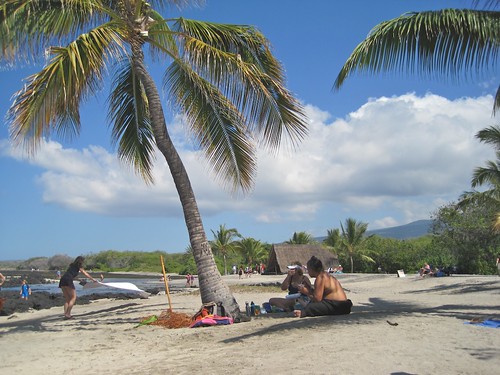 |
| Kona Airport, February 25, 2013 |
Tuesday, February 26, 2013
Goodbye, Hawaii
Saturday, February 23, 2013
Fish, Whales, Dolphins, Turtles
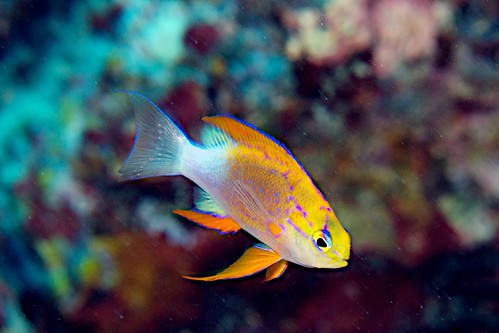
This photo shows a longfin anthias, a fairly rare fish which Len has been hoping to see for several days. The very accommodating diveshop, Kona Diving Company, made sure that they had one dive this morning where they found him, enabling Len to take this photo and also quite a few more -- all wonderful, in my opinion.
The entire boat trip today was unusually wonderful, as I already wrote to a few relatives. Before we were even much outside of the harbor we saw spinner dolphins on the surface, probably sleeping; then a big bottle-nose dolphin swam past us and went under the boat. Later we saw a pod of around 3 humpback whales jumping, breaching, and lifting their pectoral fins out of the water. They were around us for around the next 2 hours. We were unusually close to them, though outside the legal 100 foot distance. Better than many whale-watching trips, though they are supposed to be really good here at this time of year, when whales are migrating past the islands.
Diving and snorkeling -- which was what the boat trip was supposed to be for -- were both great. I snorkeled with a turtle and watched a school of fish swim under an archway in the coral and come out on the other side. Lenny saw a lot of stuff underwater, and took great photos, as I mentioned. I had my little camera with us, but the dolphins and whales weren't close enough for that type of photography. It was very sunny on the water, while at the same time, up on the mountain there was thunder and hail. (The captain's brother texted him about hail at 1500 feet).
So it was a nice end to our boat trips this time -- we don't have any scheduled for tomorrow, and our plane out is Monday. We hope the weather will cooperate with our scheduled planes coming back.
PS From the sea-facing terrace of the restaurant where we ate dinner, we saw a beautiful sunset with a real, though slightly anemic, green flash!
Tuesday, February 19, 2013
Tulgey Wood
As you walk from the parking lot at Honokohau Harbor to the nearby beach at the national historical park, you go through a very small wooded area which seems rather magical and tulgey! The parking lot is really ugly, so the woods seem very secluded and mysterious, like many of the dreamy sequences in Alice in Wonderland. Also, as you emerge from the woods the beach is dramatic, a cove surrounding the ruins of an ancient fish trap.
I've posted photos of the beach many times -- here are a couple of them from a few days ago showing the thatched shelter which I think would have originally been a place to store canoes, and showing the fish trap:
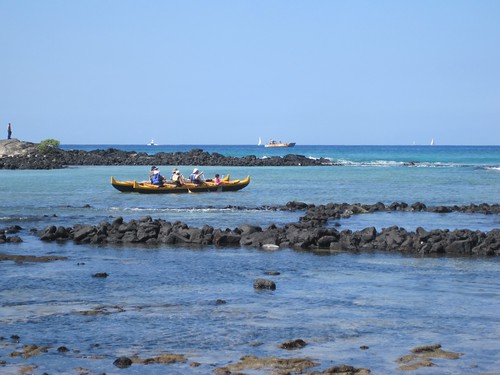 |
| Ancient Fish Trap and Two-Hulled Canoe at Honokouhau |
Sunday, February 17, 2013
Hula Dances
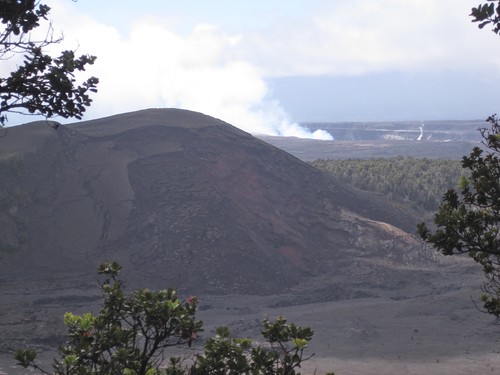 |
| Fumes rising from the crater at Volcano National Park |
When we first arrived, it was really raining hard, and a scheduled hula performance, which was supposed to take place in view of the crater, had been moved inside to the visitor center auditorium, usually used to show movies (so I couldn't get any good photos). The leader was an older man who chanted traditional song-stories in the Hawaiian language about the gods and kings of old Hawaii. A woman read a translation of the songs with some background information.
 |
| Hula dancer, Volcano National Park |
Today we saw a quite different hula performance at the monthly crafts market that occupies the main shopping street of downtown Kona. These dancers were very skilled, though the traditional song accompanying their dance may be a bit more recent -- "Little Grass Shack in Kealakekua, Hawaiʻi" -- written in 1933 in English with a few Hawaiian words. Traditions being what they are, the Hawaiian-language chants we heard yesterday could actually have been written more recently for the revival of pre-contact Hawaiian arts, but I don't really know. Everything about local history here is perplexing.
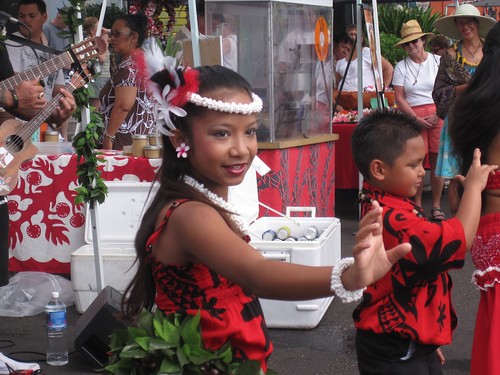 |
| Hula Dancers, Kona Sunday Craft Market |
 |
| Hula Dancers, Kona |
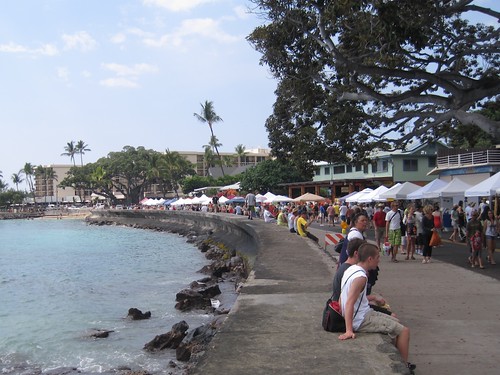 |
| The market stalls, under their awnings, line the road along the waterfront |
Friday, February 15, 2013
Puako Petroglyph Park
We walked around 1.5 miles today through a tulgey wood to a petroglyph field. (Len thinks the wood wasn't quite damp enough to be really tulgey, but I found it tulgey.)
The petroglyphs were carved by Hawaiians in the early days, around 300 years ago. They walked a long trail parallel to the beach, sleeping in small natural shelters in the rock. Little is known about why they walked and why they carved many images in certain fields of lava rock. Here are a few examples.
 |
| Me taking photos of the petroglyph field |
Saturday, February 09, 2013
Where Ancient Hawaiians Lived
 |
| Lapakahi State Historical Park |
The northwest tip of the Big Island is called North Kohala district. Prior to Captain Cook's first contact between Europeans and Hawaiians, and for some time after that, this area was home to a number of farming and fishing villages. One village, called Lapakahi, is now a state park including roughly reconstructed buildings and stone foundations illustrating ancient villagers' lives. By the shore are a canoe shelter, shrines to fishing gods, and salt pans. Up the hill are homes, lookout points for watching the ocean, and a burial ground. The lookout point served us as a good place to watch for whales, and we saw a few of them blow and breach.
Around the tip, facing northeast, is the Pololu valley, first in a series of now uninhabited valleys. The path down to the valley is very steep, but the views are spectacular as you climb down the 400 foot drop. It can't be that hard -- we saw some girls walking down the rocky path in bare feet, and saw families with rather small children scrambling quickly down the trail. We carried down some sandwiches and coke and had a picnic. (Yes, we took all our trash back up the hill and put it in a trash can in town!)
 |
| From the trail to Pololu Valley: The first look along the coast always reminds me of the illustrations for fantasy books about some other planet. |
 |
| Walking on Pololu beach |
 |
| The valley -- behind this treed area is a lagoon |
A water project diverted the stream, and cultivation ended -- the last inhabitants left in the 1940s -- I wonder if the tsunami that wiped out quite a lot of that coast at that time was the reason for the final abandonment. Now there's only a rather rough trail that crosses the ridges of hills. I believe several days are required to walk to the next inhabited area, which is the Waipio valley north of Hilo. (It was definitely abandoned after the tsunami, though a few people have now returned.)
Thursday, February 07, 2013
Diving Feet
On the dive boat today, I noticed these fins that belong to the boat's owner, who is also a dive guide.
For several more photos of fish and dive-boat scenes see this flickr set:
http://www.flickr.com/photos/len2000/sets/72157632715523046/
For several more photos of fish and dive-boat scenes see this flickr set:
http://www.flickr.com/photos/len2000/sets/72157632715523046/
Sunday, February 03, 2013
African Reading and Art
 |
| "Group Photo 1987," wood sculpture by El Anatsui |
 |
| King Peggy, recently featured on CNN, leads a village in Ghana |
Some of Anatsui's works are representational and some are more abstract; I found all of them beautiful and fascinating. One large work, "Akua's Surviving Children" (which I didn't get an image of) was made from driftwood, and represented the slaves who had left the country. I also enjoyed the wood sculptures of people titled "Group Photo 1987."
The vivid and modern interpretations of life in Ghana and Nigeria, represented in a completely modern and (I think) western European artistic mode, connected in my mind to two things I have read in the past week.
For one thing, CNN ran a feature on a woman who lives in Washington, D.C., and works as a secretary, but who was chosen by the town Otuam, a fishing village on the coast of her native country Ghana, to be their king. In Otuam, "king" is the traditional title for the ruler, man or woman. The photos and videos with this story showed King Peggy in her vivid robes of office and crown. In fact, she explained, she owned several crowns!
King Peggy's 7000 people are quite poor, and she has raised money to bring them clean water and an ambulance, and seems to be engaged in other ways of raising their standard of living. They seem to adore her (I hope CNN is telling the truth) and they carry her on a palanquin with a huge umbrella. "In the last few years, she's helped poor families pay school fees for their children and brought computers to classrooms. With the help of other Americans she's also provided Otuam with its first ambulance, as well as access to clean, running water. Her next priority, she says, is to bring state-of-the-art toilets to Otuam."
Amos Tutuola's folk-like tale The Palm-Wine Drinkard has long been one of my favorite African stories. By coincidence, last week I also read a new Kindle edition of some shorter tales that he wrote, "Don't Pay Bad for Bad." The stories take place in Yoruba villages in Nigeria, and are told, according to a preface by Tutuola's son, in an English very much influenced by the idioms of the Yoruba language. His son points out that over his life, Tutuola was both admired and criticized for his fusion of African and English themes and idioms, and that in his later works (which I haven't read) he tried to make his language more conventional.
Village market places, village kings, and relationships among the villagers are central to these stories. Some of them are fables with a moral, like the title story "Don't Pay Bad for Bad," in which a jealous woman tricks another woman, who plots for years to pay her back -- but her revenge is so cruel that she simply gives it up. Famine stalks one village, but an individual finds supernatural beings who will help him on promise of secrecy; of course the secret is discovered by a trickster who is up to no good. The need for food and fear of hunger are very important in these tales, which connects them in my mind to the depictions of market themes in Anatsui.
 |
| El Anatsui wall hanging made from bottle caps, which reminded me of a work by Klimt |
 |
| Hundreds of metal boxes made by tinkers. Title "Open(ing) Market" |
 |
| El Anatsui exhibit: on the floor, a ceramic sculpture on the far wall, wooden plates carved by artisans and decorated by the artist |
Saturday, February 02, 2013
Hill Auditorium at 100 years old
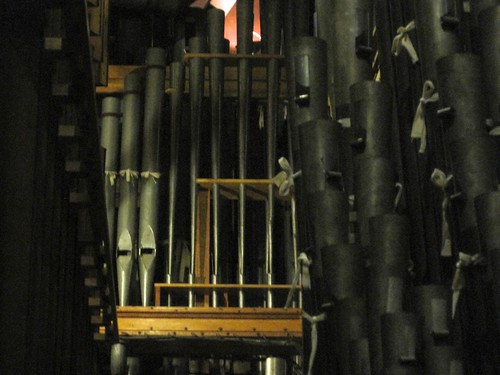
Today we attended a celebration of the 100th anniversary of Hill Auditorium, a famous and acoustically "perfect" space designed by Albert Kahn. We remember many enjoyable concerts there over the years, by many famous music stars who seemed to love performing there. Among our memories: Andres Segovia, Vladimir Horowitz, Leontyne Price, Cecelia Bartoli, and our own daughter who once performed there with Michigan Youth Symphony.
The celebration started with a lecture on the way Hill's acoustics work, sponsored by Saturday Morning Physics. The lecturer was Scott Pfeiffer who served as the lead consulting acoustician on Hill Auditorium’s 2004 renovation. We learned a lot about the original design, as well as about the renovation and its goals. The parabolic shape of the interior was invented for Hill, and has unique results in terms of amplifying the sounds onstage, especially those at the focal point of the parabola. The size of Hill is also exceptional among other acoustically renowned auditoriums -- it seats 3700 people, more than twice the average size of a similar venue. You can hear a dime dropped from a few inches above the floor -- as the lecturer demonstrated.
After the lecture the audience was invited to a self-guiding tour as well as to other presentations throughout the day. Above, a photo of the real organ pipes as seen from behind the stage, which one rarely gets to see. They are impressive though the place where they are located is very crowded; we waited in a long line to view them after the lecture. Here are a few more photos from this morning.
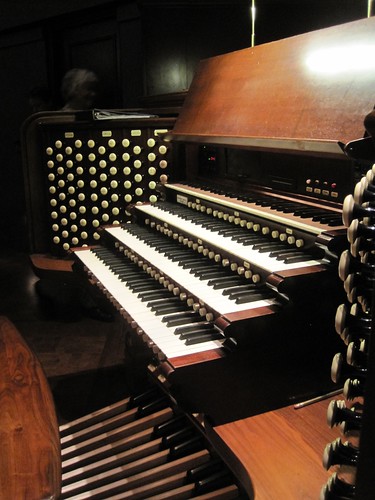
The organ was built for the 1892 Columbia Exposition and purchased shortly thereafter by the University of Michigan. This morning to start the day's events, a music school organist played variations on the Star Spangled Banner -- a popular piece over 100 years ago. The same variations were performed in 1895 when the organ was new at Michigan, obviously before it found its current home in Hill.
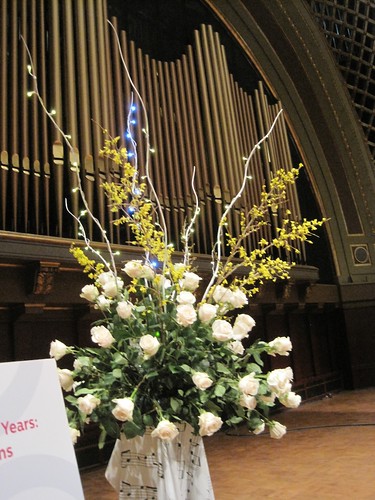
The organ pipes as seen from the stage are just for decoration. The real pipes are behind the decorative ones, and look completely different -- instead of neat rows, they are almost chaotic and very close together.
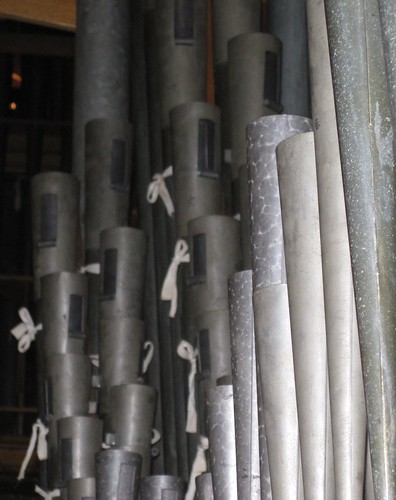
The view from the stage is quite different from the view from the audience --
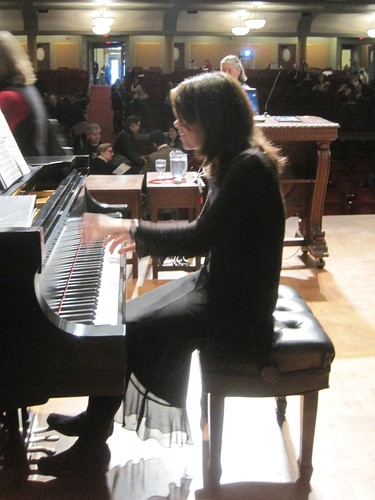
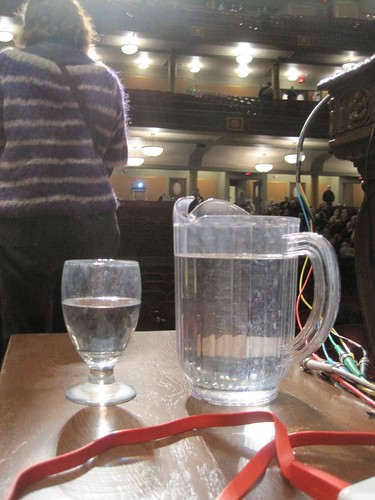
In a dressing room behind the stage they had recreated what might have been there when Leonard Bernstein performed. He gave his cape to the head of University Musical Society as a gift, once, and they had it in the closet --
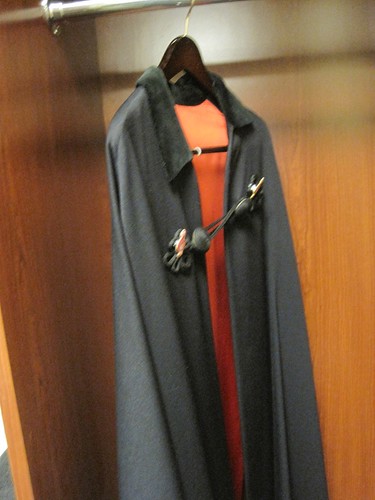
Subscribe to:
Comments (Atom)


